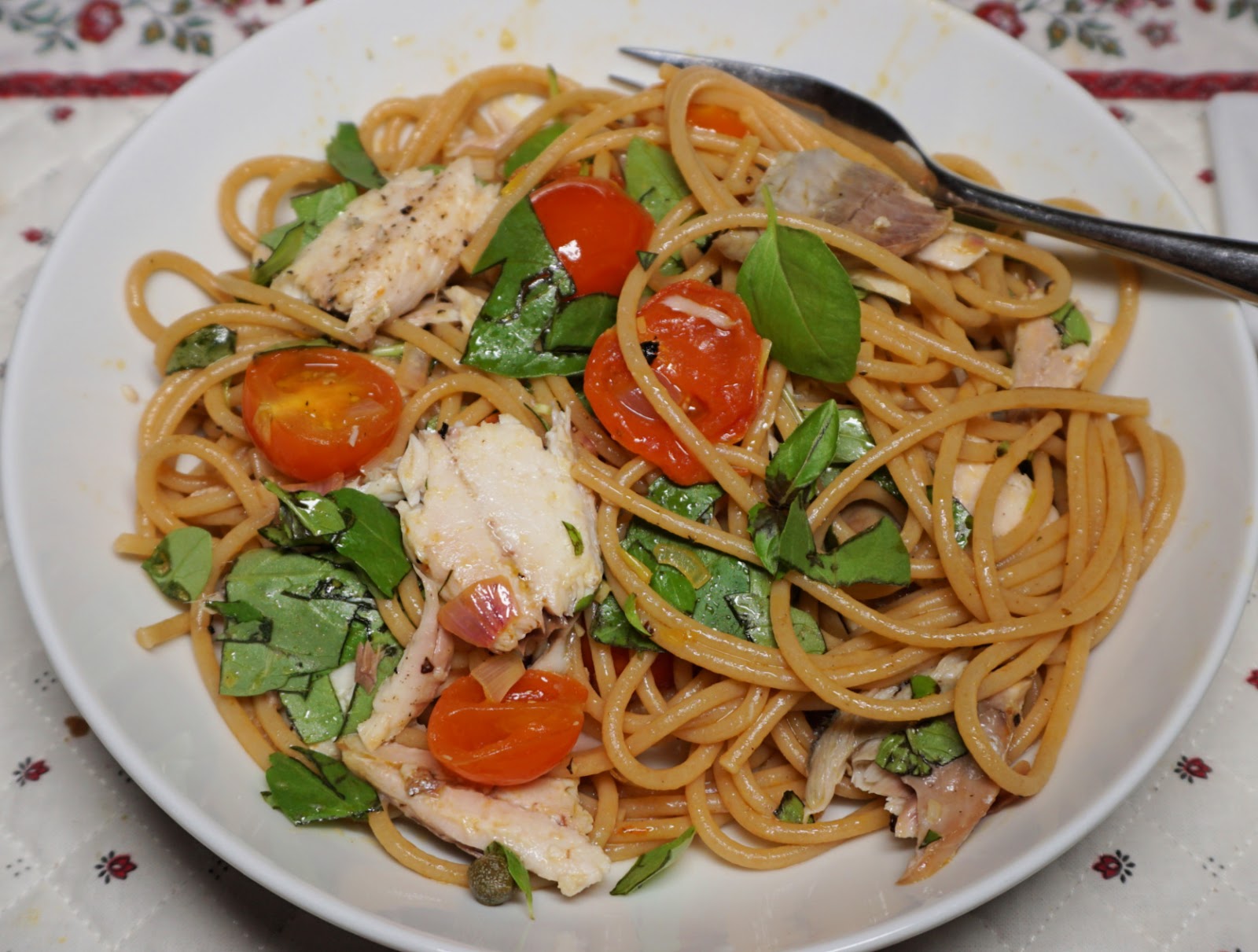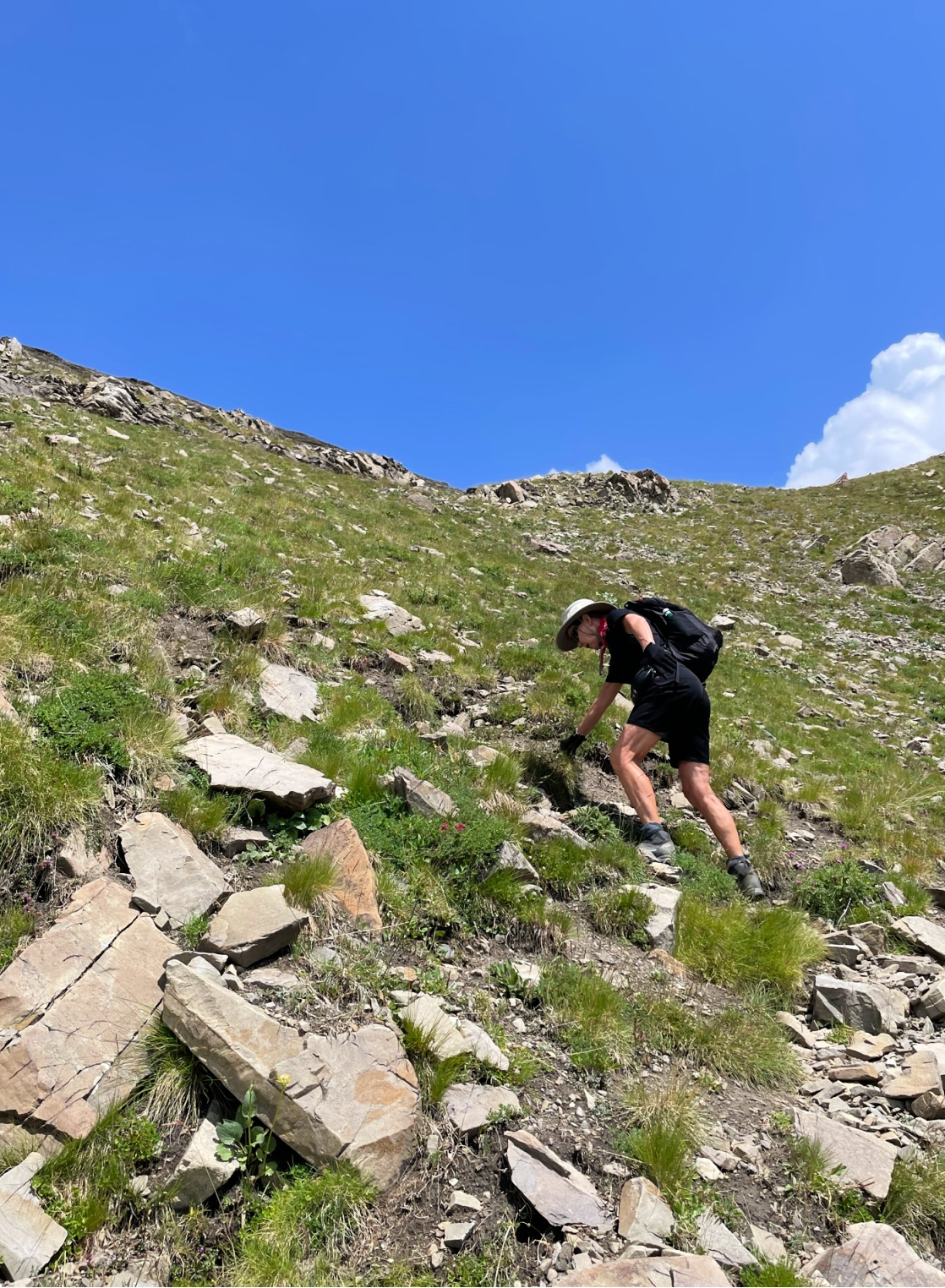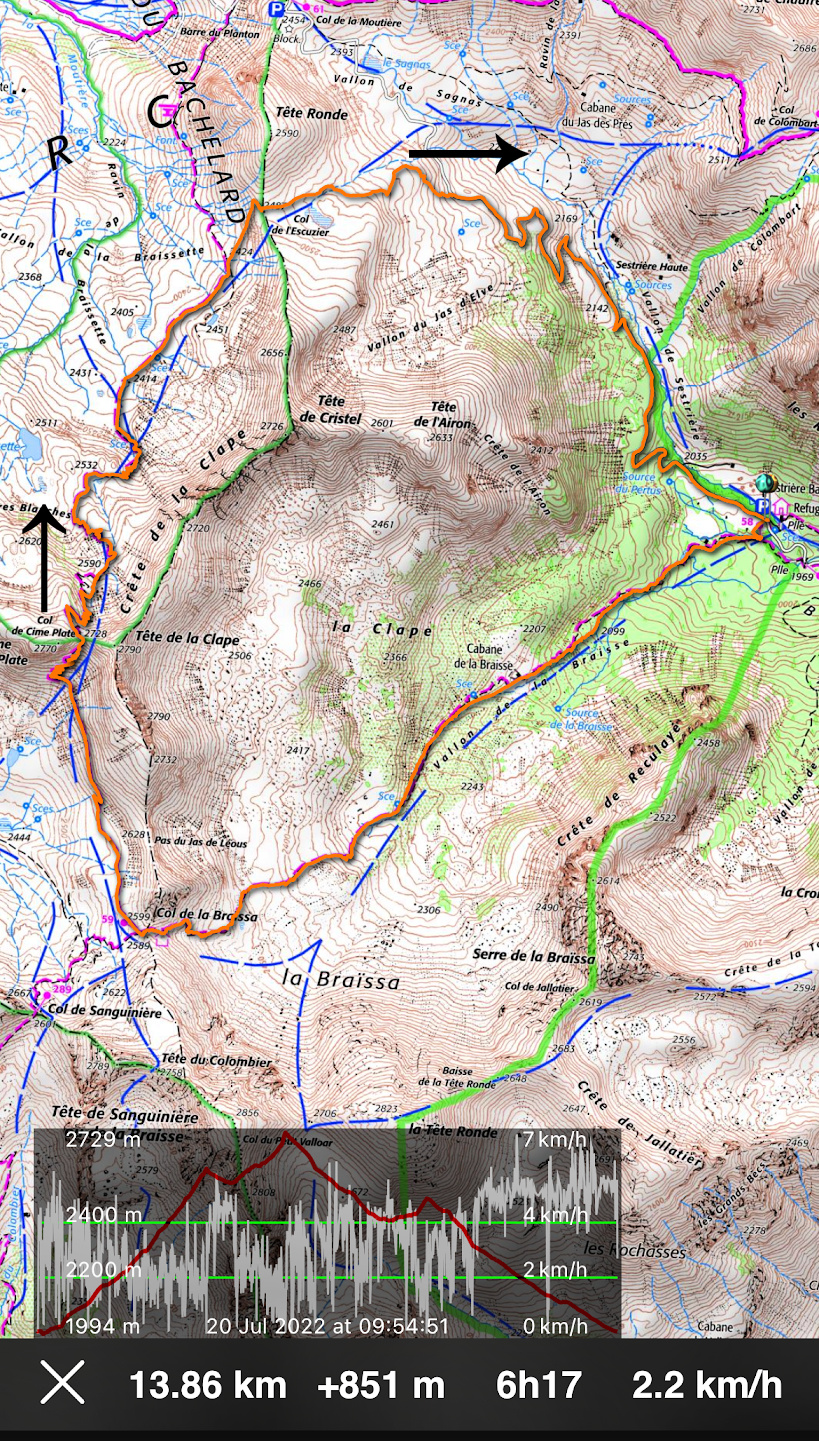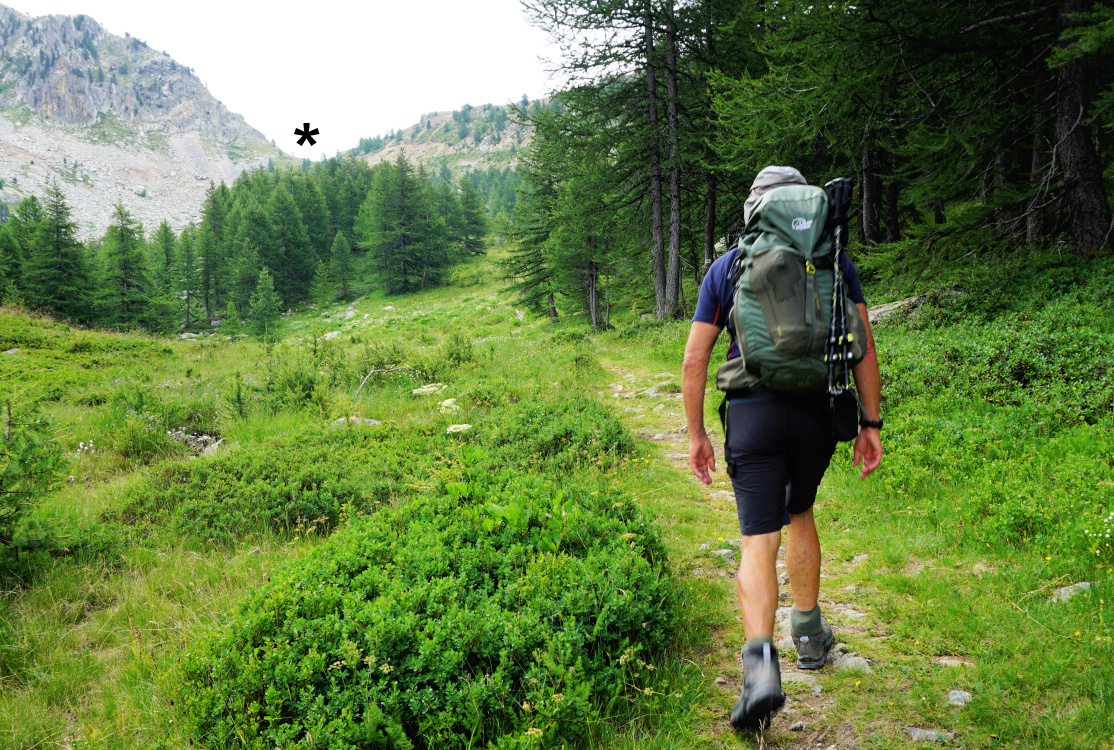Col Tronchet (2661 m) above Ceillac is one of the mountain passes connecting the Queyras Region with the Ubaye Valley. It is possible to drive about 6 km in the Mélézet Valley to the very end of the narrow but paved road to a parking (not paved; at 1965 m elev.), used mainly for hikes up to the Ste-Anne Lake.
 |
| Start to Col Tronchet |
 |
| Climbing to Col Tronchet |
 |
| Col Tronchet in sight |
Starting in the forest, we ascended along the main trail to about 2100 m where a signpost showed the itinerary both to the lake and Col Tronchet. We continued straight, heading to the southeast and eventually reached wide Alpine meadows, following Torrent du Tronchet.
To our right, we had Tête de Girardin (2876 m), and a bit further to the west, another ancient optical telegraph post on the ridge. Incidentally, we had visited such a post on Crête des Chambrettes the previous day. To our left, the sharp relief of Rocher de l’Eissassa (3048 m) was the only summit in the Tronchet sector reaching 3000 m.
 |
| Tête de Girardin |
 |
| View to west from Col Tronchet |
 |
| Descent from Col Tronchet |
 |
| Alpine meadow by the Tronchet trail |
Today’s goal had been visible in front of us since leaving the forest. Nearing the mountain pass, the meadows were replaced by rockier and steeper terrain. The solitude was remarkable. There was just a sporadic hiker on the trail.
The final ascent was quite steep and the trail was narrow. Once on the col, we had views both to Ceillac and to the Chambeyron Massif with several 3000+ peaks on the south eastern side of the Ubaye Valley. The trail continued down to Maljasset.
We descended back along the same trail.
Map: 3537ET Guillestre and 3637 OT Mont Viso
 |
| Col Tronchet hike track |
This is a warming dish to be made in autumn and winter. The choice of ingredients is not very different from the classic coq au vin but whole grain mustard, moutard à l’ancienne, gives the dish a special twist.
Make this in a heavy cast-iron pot, cocotte, such as Le Creuset.
2 servings
4 chicken thighs with skin and bone
2 tbsp. olive oil
2 handfuls of sliced mushrooms
About 4 shallots, peeled and cut in half lengthwise
1 clove garlic, minced
1 tbsp. whole grain mustard
100 ml chicken stock
100 ml white wine
Freshly ground black pepper
Fresh herbs to decorate
Preheat the oven to 200°C, roast.
Warm the olive oil in a heavy pot over medium heat. Fry the chicken thighs on both sides until golden. Remove from the pot and set aside.
Add the shallots, mushrooms, and garlic to the pot and cook for a few minutes stirring occasionally. Pour in the wine and chicken stock scraping up any browned bits. Stir in the whole grain mustard and return the chicken thighs skin side up nestling them into the mushrooms and shallots. Pour in any accumulated juices from the chicken. There should be enough liquid in the pot so that the chicken thighs are partly covered.
Transfer the pot in the oven and braise uncovered for 40- 45 minutes. The chicken skin should be nicely browned and the meat very tender.
Serve the chicken with brown or black rice. Grind over some black pepper and sprinkle with chopped herbs.
 |
| Optical telegraph post Chambrettes |
Situated in the Queyras Regional Nature Park, Ceillac is a true hikers’ mecca. A few days’ stay is just not enough to explore all the opportunities.
The following hike features a great loop above Ceillac, circling via the Chambrettes Ridge, Crête des Chambrettes.
As late as in 1899/1900, the French army built a chain of optical telegraph posts* in the Alps. The purpose was to communicate between Nice and Lake Geneva (and beyond). One of these posts was built on Crête des Chambrettes on a spot where the ridge (2555 m) is narrow, only about 100 m from the highest point (2582 m).
 |
| GR58 above Ceillac |
 |
| Near Col de Bramousse |
 |
| Col de Bramousse |
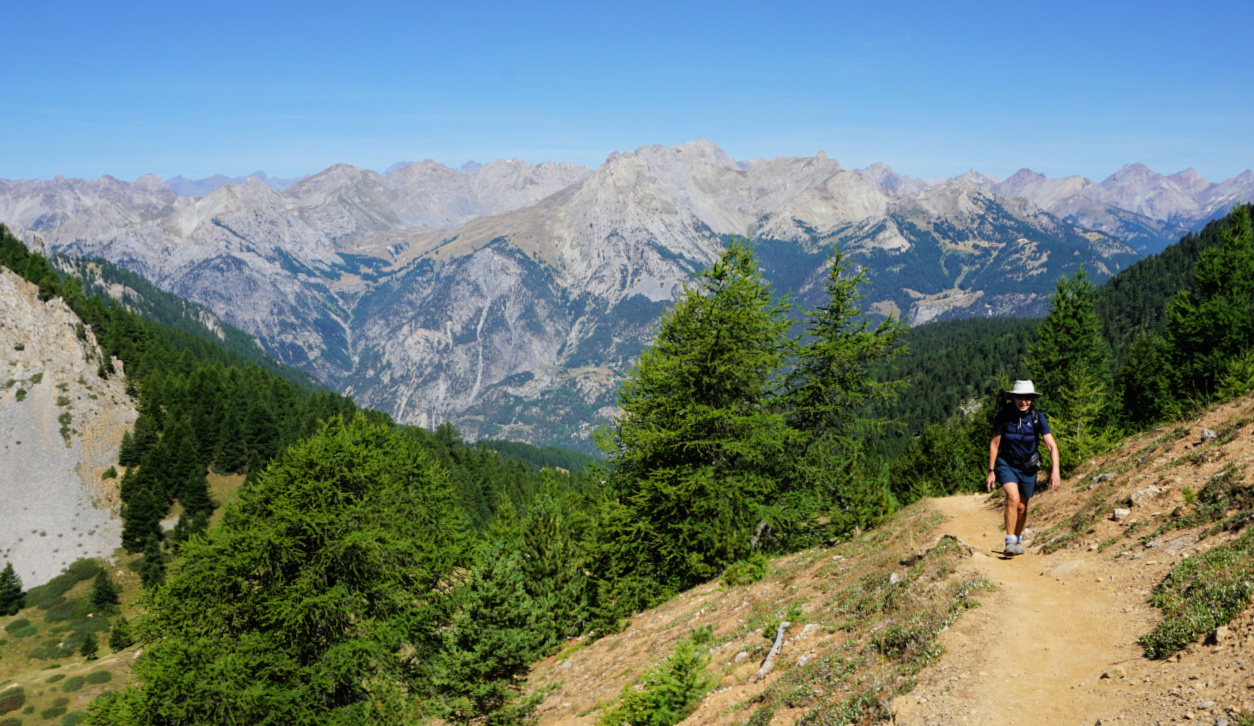 |
| Above Col de Bramousse |
We started from Ceillac (1640 m), followed the GR58 long distance trail passing the Ste-Cécile church where we headed north and soon ascended quite steeply in the Bois de Cheynet Forest towards Col de Bramousse (2251 m).
From the col, we forked right (east) along the GR58 variant, and continued the ascent, now above the tree line. Ignoring the detour to the Jean Grossan lookout point, we entered the southern flank of the ridge and climbed to the small stone hut tower restored in 1997. The views from here were simply stunning. The northern flank was precipitous.
 |
| Jean Grossan lookout point |
 |
| Cristillan Valley |
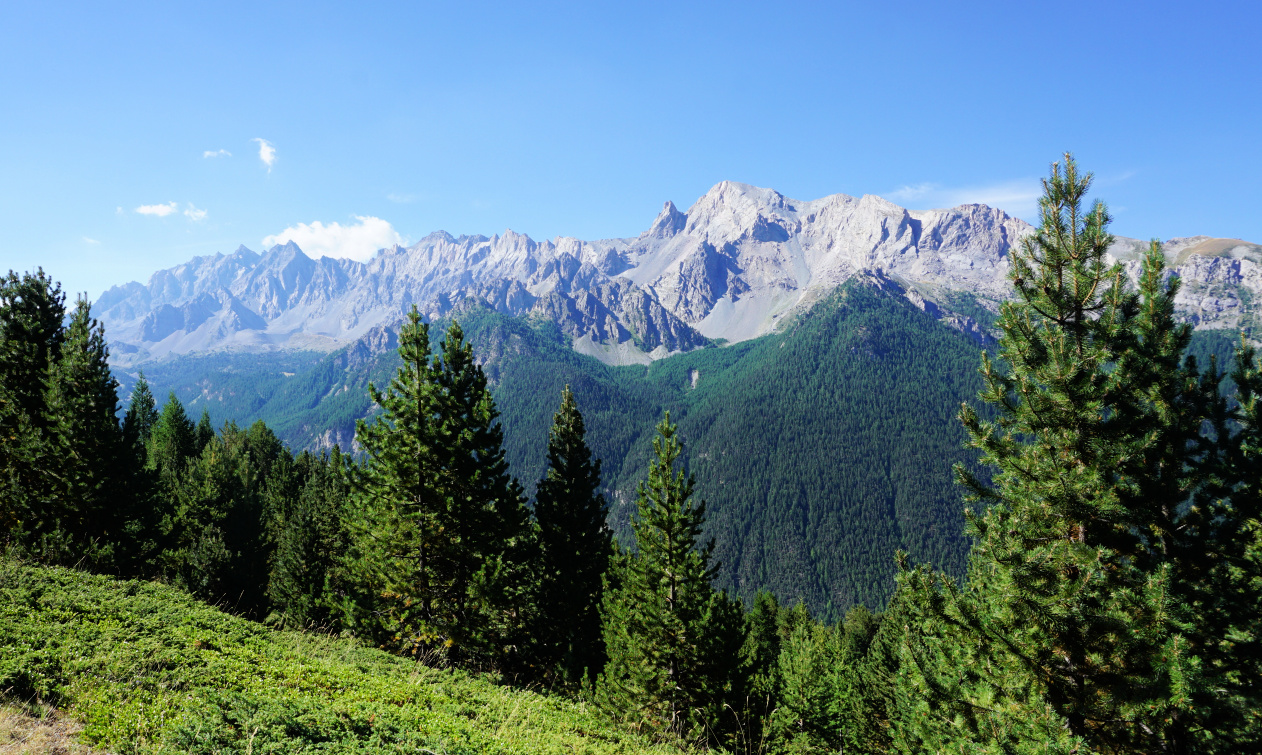 |
| Peaks south of Ceillac |
 |
| Ceillac seen from Crête des Chambrettes |
 |
| Eastern Crête des Chambrettes |
We descended along the main trail to the east as far as to Col de Fromage (2301 m; a major crossroads of trails) where we forked right and descended along GR5/58 back to Ceillac, passing the hamlet of Villard in the Cristillan Valley.
Map: 3537 ET Guillestre Vars.Risoul PNR du Queyras (or 3537 OT)
* https://www.envie-de-queyras.com/guide/poste-optique-des-chambrettes
 |
| Near summit of Crête des Chambrettes |
 |
| View west from Crête des Chambrettes |
 |
| Return from Col Fromage |
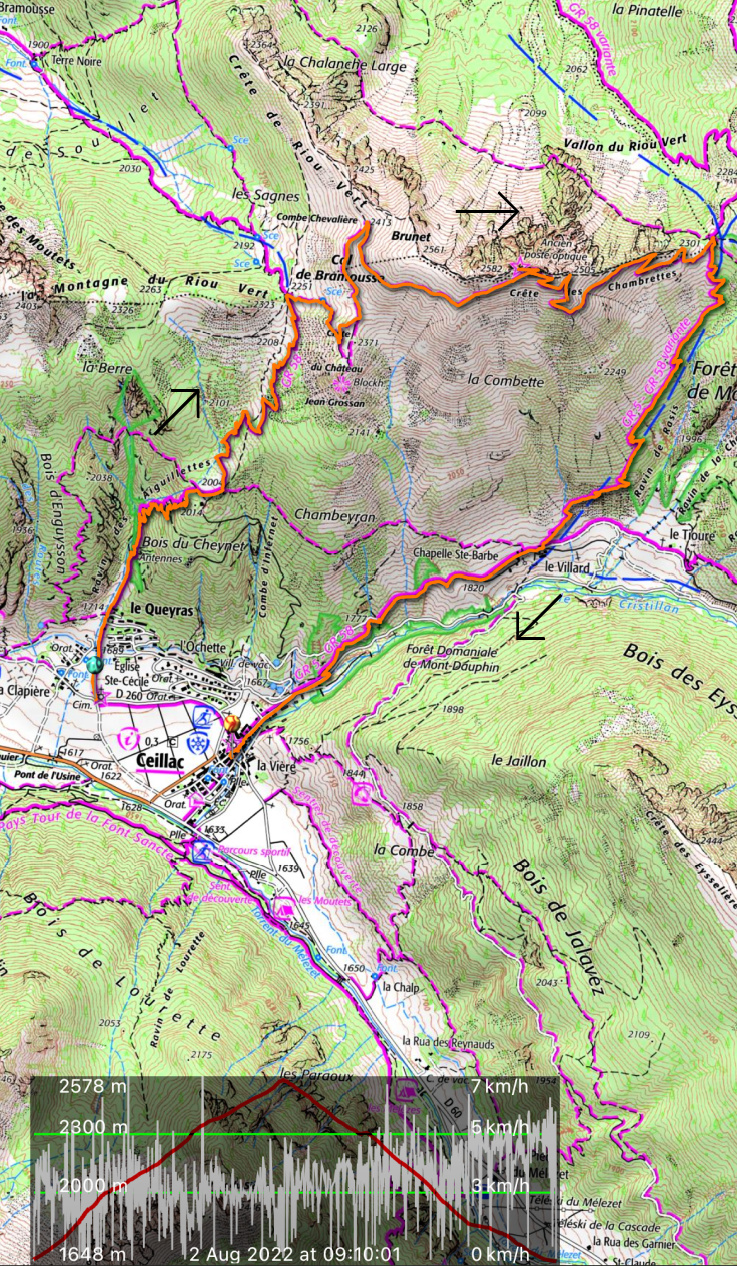 |
| Crête des Chambrettes hike track |
Mackerel is a good source of heart- healthy omega- 3 fatty acids. Being low in the food chain, it accumulates much less toxins and heavy metals than tuna or swordfish. If you find fresh mackerel fillets in your shops, this is a recipe to try.
2 servings
2- 3 mackerel fillets
10- 12 cherry tomatoes, halved
3 shallots, chopped
1 clove garlic, minced
2 tsp. small capers
Olive oil
Freshly ground black pepper
Whole wheat spaghetti for 2 servings
A good handful of chopped basil
Preheat the oven to 200° C, roast. Roast the mackerel fillets, skin side up, for 10 minutes. Remove the skin and cut the mackerel into smaller pieces. Set aside.
Meanwhile cook the spaghetti according to the advice on the package.
Warm 2 tbsp. olive oil in a large frying pan over medium heat and sauté the cherry tomatoes, shallots, and garlic for 10 minutes. Add the capers, black pepper and the cooked and drained spaghetti and mix. Fold in the mackerel pieces and basil. Divide into bowls and serve.
These tasty small open sandwiches make a light lunch served with some green side salad. You could add some hummus with the salad.
2 servings
4 small slices of soft and fresh rye bread
2 tbsp. olive oil
1 shallot, sliced
1 clove garlic, minced
1 red bell pepper, sliced
1 green bell pepper, sliced
2 tasty tomatoes, sliced
4 slices of low- fat goat cheese
Warm the olive oil over medium heat in a frying pan. Sauté the vegetables until soft.
Divide the vegetables on the bread slices and top with goat cheese.

































